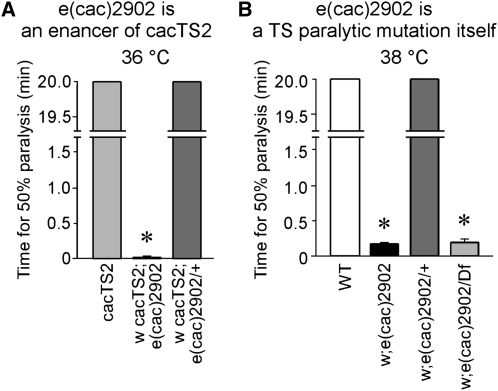Figure 1 .
A genetic modifier screen identifies a second chromosome enhancer of cacTS2. (A) e(cac)2902 is an enhancer of cacTS2. The double mutant, w cacTS2; e(cac)2902 exhibits rapid paralysis at 36°, whereas cacTS2 alone does not paralyze at this temperature. Flies heterozygous for the enhancer mutation [w cacTS2; e(cac)2902/+] exhibited a cacTS2 behavioral phenotype, indicating the mutation is recessive. Behavior tests for cacTS2 and w cacTS2; e(cac)2902/+ were truncated after 20 min. Time for 50% paralysis in the w cacTS2; e(cac)2902 double mutant was 1.3 ± 0.60 sec (n = 5). (B) e(cac)2902 is a TS paralytic mutation itself. e(cac)2902 in a cac+ genetic background exhibits paralysis at 38°, whereas wild-type flies (WT) do not paralyze. Flies heterozygous for the e(cac)2902 mutation exhibited a wild-type behavior, indicating the mutation is recessive. Flies carrying e(cac)2902 in trans to Df(2R)14F06W-07 exhibit the e(cac)2902 paralytic phenotype. Times for 50% paralysis in e(cac)2902 and e(cac)2902/Df(2R)14F06W-07 were 9.8 ± 1.77 sec (n = 5) and 11.2 ± 3.12 sec (n = 5), respectively. Behavioral tests for WT and e(cac)2902/+ were truncated after 20 min. Asterisks mark values significantly different from control values. Here, and in subsequent figures, error bars indicate SEM, and asterisks denote statistical significance.

